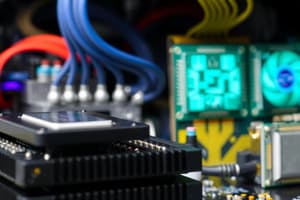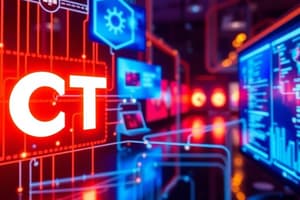Podcast
Questions and Answers
What is the purpose of the address bar in a web browser?
What is the purpose of the address bar in a web browser?
- To control the browser's zoom level
- To display the current webpage's URL (correct)
- To display the current webpage's title
- To show the progress of the current webpage's download
What is the function of the 'GO' button or the 'Enter' key when used in conjunction with the address bar?
What is the function of the 'GO' button or the 'Enter' key when used in conjunction with the address bar?
- To refresh the current webpage
- To load the webpage specified in the address bar (correct)
- To open a new tab
- To close the current webpage
What is a website address composed of? (Select all that apply)
What is a website address composed of? (Select all that apply)
- Domain Extension (correct)
- Hypertext Transfer Protocol (correct)
- Web server name (correct)
- Protocol version
What does the '.gov' domain extension typically indicate?
What does the '.gov' domain extension typically indicate?
What is the purpose of the status bar in a browser?
What is the purpose of the status bar in a browser?
Which of the following is a valid example of a website address?
Which of the following is a valid example of a website address?
Which domain extension is commonly associated with educational institutions?
Which domain extension is commonly associated with educational institutions?
What is the primary function of a web browser?
What is the primary function of a web browser?
What is the main function of the Arithmetic-Logic Unit (ALU)?
What is the main function of the Arithmetic-Logic Unit (ALU)?
Which device is used to input spoken words into a computer?
Which device is used to input spoken words into a computer?
What is the primary function of a barcode reader?
What is the primary function of a barcode reader?
Which of the following devices is NOT considered an input device?
Which of the following devices is NOT considered an input device?
What type of operation does the ALU perform when comparing two numbers?
What type of operation does the ALU perform when comparing two numbers?
What is the primary role of the Control Unit in a CPU?
What is the primary role of the Control Unit in a CPU?
Which of the following is NOT a component of the CPU?
Which of the following is NOT a component of the CPU?
What is the main purpose of an output device?
What is the main purpose of an output device?
What is the primary difference between RAM and ROM in terms of data storage?
What is the primary difference between RAM and ROM in terms of data storage?
Which of the following is NOT a type of secondary storage device?
Which of the following is NOT a type of secondary storage device?
What is the purpose of a Secure Digital (SD) card?
What is the purpose of a Secure Digital (SD) card?
Which of the following is a characteristic of an Optical Disk?
Which of the following is a characteristic of an Optical Disk?
Based on the provided information, which of these statements is TRUE about secondary storage devices?
Based on the provided information, which of these statements is TRUE about secondary storage devices?
According to the table provided, which of the following statements is TRUE about ROM?
According to the table provided, which of the following statements is TRUE about ROM?
What is the primary function of a USB flash disk?
What is the primary function of a USB flash disk?
Which of the following secondary storage devices is most commonly and usually the largest in a computer system?
Which of the following secondary storage devices is most commonly and usually the largest in a computer system?
What is the primary purpose of the internet, as described in the text?
What is the primary purpose of the internet, as described in the text?
What is a computer network?
What is a computer network?
Which of the following is NOT a characteristic of the internet?
Which of the following is NOT a characteristic of the internet?
What is the difference between the internet and the world wide web?
What is the difference between the internet and the world wide web?
What is the significance of the internet for students, researchers, and professionals?
What is the significance of the internet for students, researchers, and professionals?
What are the three types of networks that make up the internet?
What are the three types of networks that make up the internet?
Which of the following is an example of a web browser?
Which of the following is an example of a web browser?
Which of the following is a common use of the internet?
Which of the following is a common use of the internet?
Which of the following is NOT a common input device?
Which of the following is NOT a common input device?
What is the primary function of a keyboard in a computer system?
What is the primary function of a keyboard in a computer system?
What does a scanner do?
What does a scanner do?
Which input device is typically used for drawing on a computer screen?
Which input device is typically used for drawing on a computer screen?
How do touch screens interact with a computer?
How do touch screens interact with a computer?
Which of the following is NOT a commonly recognized input device?
Which of the following is NOT a commonly recognized input device?
What is the purpose of using a camera as an input device?
What is the purpose of using a camera as an input device?
What makes a mouse a useful tool for interacting with a computer?
What makes a mouse a useful tool for interacting with a computer?
What is the primary role of a user in an ICT system?
What is the primary role of a user in an ICT system?
What is the difference between data and information?
What is the difference between data and information?
Which of the following is NOT an example of data?
Which of the following is NOT an example of data?
Which of the following best describes the process of data interpretation?
Which of the following best describes the process of data interpretation?
In the provided example, how does the data about the students' ages become information?
In the provided example, how does the data about the students' ages become information?
Which of the following is NOT a basic element of an ICT system as described in the content?
Which of the following is NOT a basic element of an ICT system as described in the content?
What is the role of communication in an ICT system?
What is the role of communication in an ICT system?
What is the key difference between using an ICT system and simply processing data?
What is the key difference between using an ICT system and simply processing data?
Flashcards
Data
Data
Basic element of ICT, represents objects/events.
Information
Information
Processed data that provides meaning and context.
User
User
A person who utilizes ICT systems and technologies.
Data Processing
Data Processing
Signup and view all the flashcards
Interpretation
Interpretation
Signup and view all the flashcards
Context
Context
Signup and view all the flashcards
Elements of ICT System
Elements of ICT System
Signup and view all the flashcards
Representation
Representation
Signup and view all the flashcards
Computer Hardware
Computer Hardware
Signup and view all the flashcards
Input Devices
Input Devices
Signup and view all the flashcards
Keyboard
Keyboard
Signup and view all the flashcards
Mouse
Mouse
Signup and view all the flashcards
Scanner
Scanner
Signup and view all the flashcards
Touch Screen
Touch Screen
Signup and view all the flashcards
Light Pen
Light Pen
Signup and view all the flashcards
Camera
Camera
Signup and view all the flashcards
Barcode reader
Barcode reader
Signup and view all the flashcards
Microphone
Microphone
Signup and view all the flashcards
Central Processing Unit (CPU)
Central Processing Unit (CPU)
Signup and view all the flashcards
Arithmetic-Logic Unit (ALU)
Arithmetic-Logic Unit (ALU)
Signup and view all the flashcards
Control Unit
Control Unit
Signup and view all the flashcards
Registers
Registers
Signup and view all the flashcards
Output devices
Output devices
Signup and view all the flashcards
Internet
Internet
Signup and view all the flashcards
World Wide Web
World Wide Web
Signup and view all the flashcards
Internet Browser
Internet Browser
Signup and view all the flashcards
Website
Website
Signup and view all the flashcards
Web Page
Web Page
Signup and view all the flashcards
Computer Network
Computer Network
Signup and view all the flashcards
Search Engine
Search Engine
Signup and view all the flashcards
Difference between Internet and Web
Difference between Internet and Web
Signup and view all the flashcards
RAM
RAM
Signup and view all the flashcards
ROM
ROM
Signup and view all the flashcards
Secondary Storage
Secondary Storage
Signup and view all the flashcards
Hard Disk
Hard Disk
Signup and view all the flashcards
Optical Disk
Optical Disk
Signup and view all the flashcards
USB Flash Disk
USB Flash Disk
Signup and view all the flashcards
Secure Digital (SD) Card
Secure Digital (SD) Card
Signup and view all the flashcards
Differences between RAM and ROM
Differences between RAM and ROM
Signup and view all the flashcards
Address Bar
Address Bar
Signup and view all the flashcards
Status Bar
Status Bar
Signup and view all the flashcards
How to access a website
How to access a website
Signup and view all the flashcards
Parts of a website address
Parts of a website address
Signup and view all the flashcards
HTTP
HTTP
Signup and view all the flashcards
Domain Name
Domain Name
Signup and view all the flashcards
Domain Extensions
Domain Extensions
Signup and view all the flashcards
Common Domain Examples
Common Domain Examples
Signup and view all the flashcards
Study Notes
Unit 1: Introduction to Information & Communication Technology
- Information and Communication Technology (ICT) plays an important role in daily life, influencing various aspects such as communication, education, entertainment, and e-commerce. In the modern world, the significance of ICT is increasingly becoming evident as it directly affects how individuals interact, learn, and conduct business.
- Information and Communication Technology (ICT) encompasses a vast array of devices and platforms, which includes the internet, mobile phones, televisions, computers, tablets, and cameras. These diverse technologies are intricately interconnected, allowing users to access, retrieve, store, transmit, and manipulate information seamlessly across different mediums. This level of integration not only enhances communication efficiency but also facilitates new avenues for learning, collaboration, and entertainment in our digitally driven world, thereby altering the way society functions on both a personal and professional level.
- Information Technology (IT) is a broader concept that encompasses the processes involved in the creation, maintenance, and use of computer software, hardware, and networks. While it specifically relates to the computation of data and the systems that manage it, ICT encompasses the broader set of technologies that enable communication, interaction, and the dissemination of information across varied platforms. This distinction is important, as it highlights how IT serves as a foundation for ICT developments.
- Data can be defined as a representation of an object or event and may take various forms, such as numbers, text, symbols, speech, or images. By itself, data does not inherently convey meaning or significance; it is merely a collection of raw facts and figures. Understanding this concept is vital, as it highlights the necessity of processing data in order to extract meaningful insights.
- Information is what emerges as a result of processing data, allowing for context and meaning to be assigned to the raw figures. In other words, when data is interpreted or analyzed, it transforms into information that can be utilized to make informed decisions or understand particular situations better. This process of converting data into information is essential for effective communication and understanding in various fields, from academia to business.
- ICT is built upon five fundamental elements: data, information, user, communication, and technology. Each of these components plays a crucial role in ensuring the effective functioning of ICT systems. Users interact with technology to facilitate communication and to process data into information, thus creating an environment conducive to growth and learning.
- A computer operates by accepting input, processing that input, and producing output based on a set of instructions known as programs. These programs guide the computer's operations and dictate how it responds to the data it receives. Additionally, programming languages allow developers to create software that can perform an array of tasks, ranging from simple calculations to intricate data analyses.
- Computers are versatile tools commonly used for communication, computation, and storage. They efficiently handle vast amounts of data and information and are capable of performing complex tasks tirelessly without needing to rest. This relentless productivity has transformed many industries and personal lives, enabling quicker decision-making and more extensive data management capabilities.
Unit 2: Computer Hardware
- This unit covers the physical components of a computer system, categorized as input, processing, output, and storage devices.
- Input devices allow data entry (e.g., keyboard, mouse, scanner, touch screen, light pen, barcode reader, microphone, camera).
- The CPU is the central processing unit, performing arithmetic, logical, and control operations.
- Output devices display processed data (e.g., monitor, printer, plotter, speaker).
- Storage devices store data permanently or temporarily (e.g., hard disk, optical disk, USB flash disk, secure digital (SD) card).
Unit 3: Computer Software
- Software can be defined as an organized set of instructions that guide a computer's mechanisms, enabling it to perform a variety of operations and tasks efficiently. These instructions are written in a programming language, which the computer executes to give users a seamless experience.
- System software is critical for the proper functioning of a computer as it acts as an intermediary between hardware and user applications. This category includes operating systems, such as Windows and macOS, which provide a user interface and manage resources, as well as utility programs that perform maintenance tasks like virus scanning and data backup. Additionally, language translators, such as compilers and interpreters, convert programming languages into machine code, allowing software applications to run.
- Application software is designed to facilitate specific user-oriented tasks and can vary widely in functionality. Examples include word processing software like Microsoft Word, which allows for document creation and editing, spreadsheets such as Excel for data organization and analysis, and database management systems that help manage and retrieve data efficiently. Graphics design software is utilized for creating visuals, while presentation software like PowerPoint is essential for creating dynamic and engaging presentations.
Unit 4: Internet
- The internet is a global network of networks that enables communication and information access
- A web browser is software used to access and display web pages on the internet, such as Internet Explorer, Mozilla Firefox, Google Chrome, Safari, and Opera
- Websites are composed of web pages, which are individual pages of information, with a home page being the primary entry point to a website
- A web address (URL) is a unique identifier for a web page.
- Search engines are tools for finding information on the internet (e.g., Google, Yahoo)
Unit 5: Security and Safety of Computer
- Proper use of computers is crucial to prevent harm to individuals and the devices themselves
- Proper use strategies include carefully handling components, turning on and off the computer safely, creating strong passwords, and maintaining cleanliness, with appropriate cleaning kits
- Computer security is protecting computer systems and information from unauthorized access
- Employing passwords is a critical security measure
- Identifying and learning to handle different user accounts
- Understanding the importance of safe procedures and appropriate cleaning for hardware
Unit 6: LOGO
- LOGO is a programming language, particularly designed to introduce children to fundamental programming concepts using geometric commands for graphics
- The MSW LOGO screen is divided into two main parts, the graphics screen, and the commander window.
- Commands typed in the command input box and saved are executed by pressing enter and are stored for later use
- Procedures are sets of commands used for repeated tasks, making coding more efficient
- LOGO commands include FD (forward), BK (backward), RT (right turn), and LT (left turn)
Studying That Suits You
Use AI to generate personalized quizzes and flashcards to suit your learning preferences.




